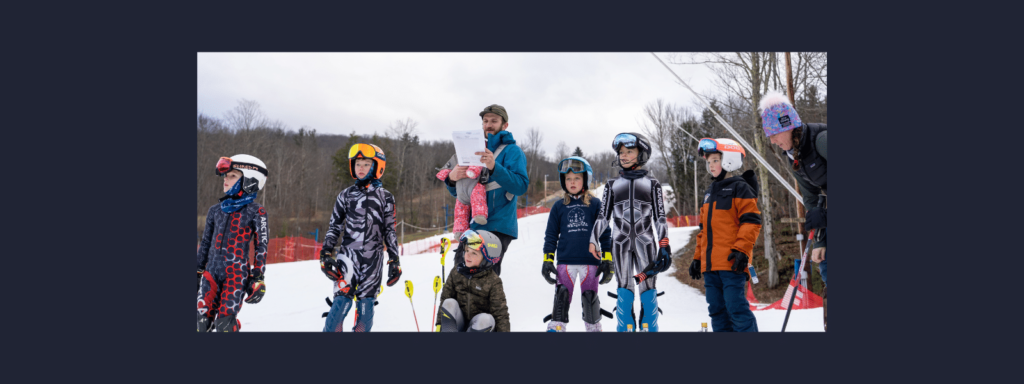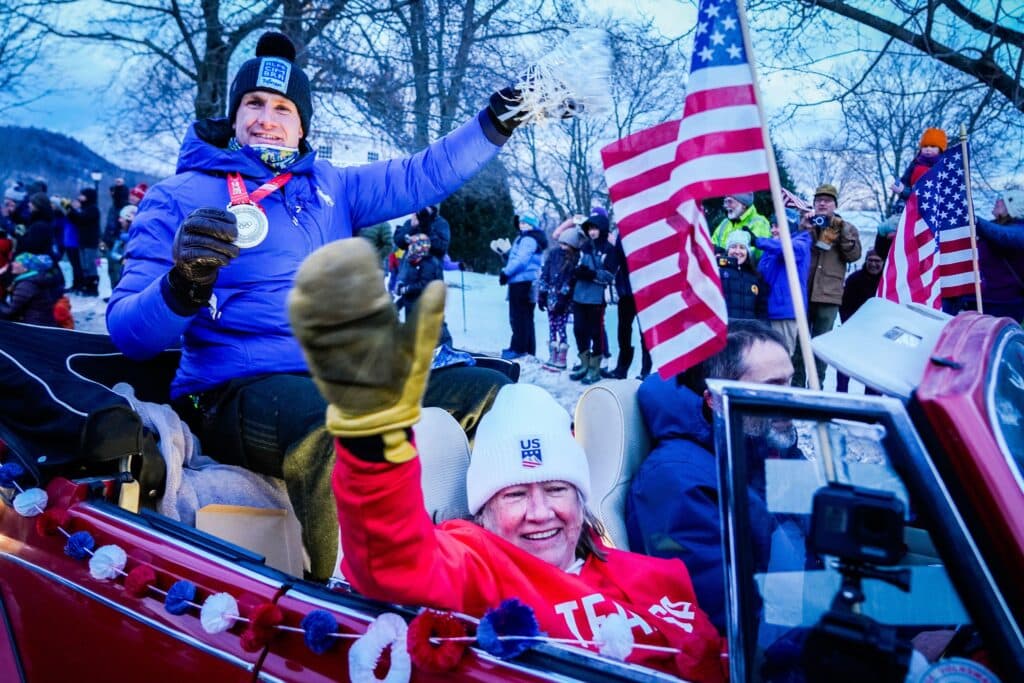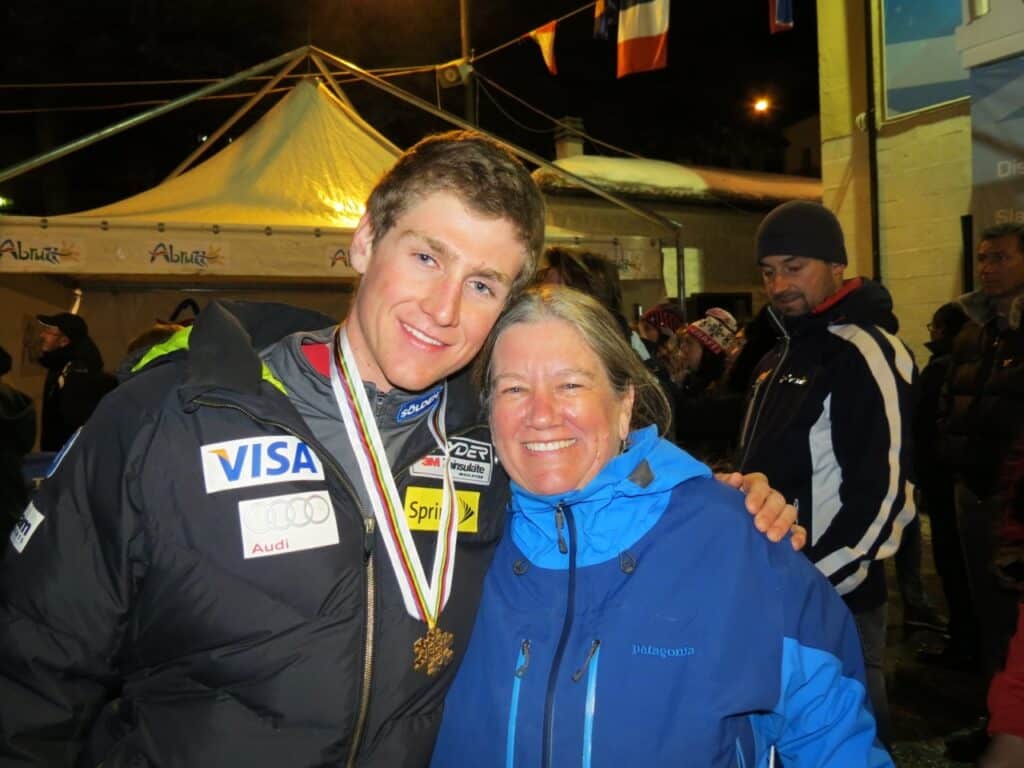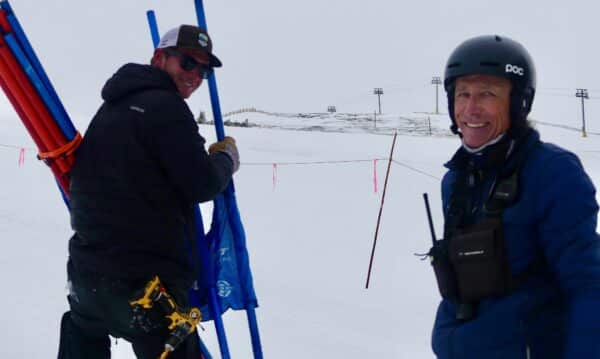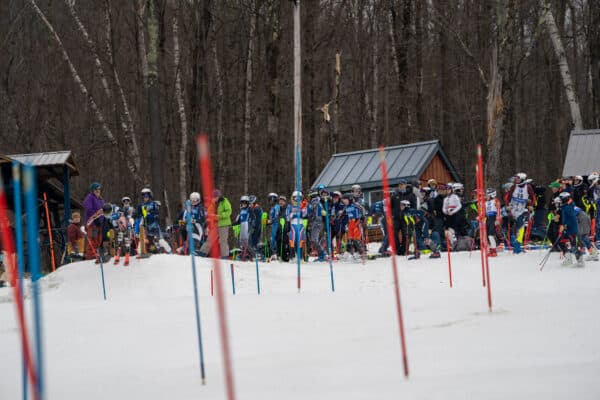Cochrans Holiday Slalom: Photo Tucker Marshall
Youth ski racing in the U.S. is at another crossroads. This article offers voices from legendary families and seasoned coaches calling for a shift. Roger Brown is a member of the esteemed Cochran family and Cochran’s Ski Club. Aldo Radamus, the Alpine Director at Team Summit, and Olympic gold medalist Barbara Ann Cochran each bring a wealth of experience and a shared vision: to balance professionalism with experiential enthusiasm for the sport. Together, they aim to inspire a constructive conversation about the future of ski racing, hoping to increase retention and make it more inclusive, enjoyable, and sustainable for young athletes.
Reevaluating Youth Ski Racing: Roger Brown’s Vision for Change
Roger Brown, a former US Ski Team member and All-American, expresses strong concerns about the direction of youth ski racing. He believes the system is broken and needs a significant overhaul to reduce commercialization and make the sport more inclusive.
The Problem with Professionalism in Youth Sports
Brown argues that youth sports in the U.S. are overly commercialized and focused on results too early. “It feels to me like we are ultimately trying to buy results at younger and younger ages,” he says. He believes the goal should be to offer the highest level of ski racing possible to as many kids as possible as long as possible.
Separating US Ski & Snowboard from the US Ski Team
Brown distinguishes between the US Ski & Snowboard (USSS) and the US Ski Team (USST).
He believes the USSS should focus on running safe, less expensive, and fair races. He suggests broad grassroots efforts for development and thoughtful, results-based pathways. These pathways should not be used for talent identification but to encourage kids to keep working hard to achieve the next level.
Meanwhile, the USST should concentrate on elite-level training and competition. “Split the USST from US Ski & Snowboard. The NGB needs to be concerned with governing and managing the sport, not high performance at any cost,” Brown emphasizes, advocating for targeted attention to address each group’s unique needs.
Focusing USSS on the Top 1500
Brown believes the USSS should focus on producing as many top 1500 skiers as possible, trusting that the top 20 will emerge from this larger pool. “Let’s see how many kids we can put in the top 1,500 in the world — if we do that, the top 20 will take care of itself,” he states. Brown argues that current policies are too focused on the top 20, which makes ski racing exclusive and expensive. “What we do now is think only about the top 20, so we put policies into place that make the whole thing more like polo than baseball in the Dominican Republic,” he adds.
Rethinking Coaching Requirements
Brown criticizes stringent coaching requirements unrelated to safety, advocating for more freedom in coaching methods and encouraging more part-time coaches to get involved. “If someone wants to coach the wrong technique or tactics, ideally, they won’t get hired. Does the coach’s education we provide result in better, more engaged coaching, particularly at younger ages? That is not evident to me. It definitely deters people from getting involved. Offer coaching education as an option to improve skills. If you threaten race venue access to get everyone to comply, you’re probably not doing it right.”
Click on images to enlarge
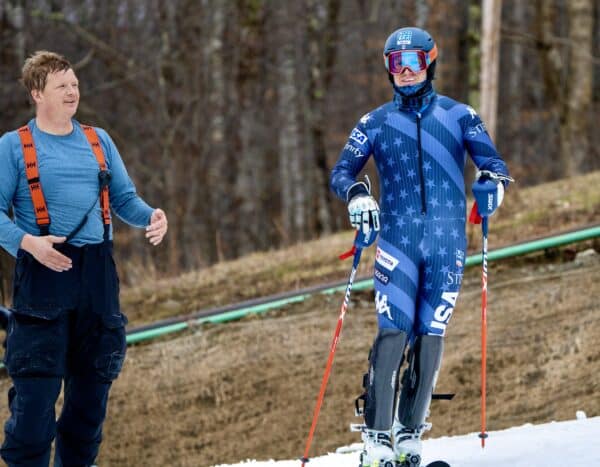
Involving Parents and Reducing Costs
Brown emphasizes parental involvement, suggesting it could reduce costs and make the sport more affordable. “Kid management is most of what we pay coaches to do, and it’s a huge part of why the sport is so expensive,” he notes. “If we have a problem with overzealous ‘little league’ parents, we need to address that, not exclude them from every aspect of training and racing,” he adds.
Making Races More Enjoyable
To make races more enjoyable, Brown proposes several changes:
- Full-Mountain Access: Every race should have a ticket valid for the entire mountain after 2 PM. This would make the highly valued freeskiing available and fun.
- Handwritten Results: For U14 and under, results should be handwritten on scoreboards to encourage face-to-face interaction and community building. Live timing results emphasize rankings, and at youngest ages, it often require an adult to access the information.
- Extended Course Time: Leave the course up for an hour after the race and have awards at the end of the day.
- Flexible Age Categories: Allow exceptional kids to race in higher age groups to mitigate the need to chase “pace” across the continent.
- Eliminate the No-Hiking Rule: Allow U12 and U10 kids to hike if they stop on the course, fostering a supportive environment. Most young kids focus more on completing the course than competing for the top ten finish. Adults yelling at athletes to get off the course is discouraging and does not increase safety.
- Create a Festive Atmosphere: Make races feel special but not overly important, creating a fun environment that inspires kids to return rather than feeling like cogs in an athlete development machine.
Conclusion: Roger Brown’s Vision for Youth Ski Racing
Brown’s vision emphasizes inclusivity, enjoyment, and reduced commercialization. By focusing on making the sport accessible and enjoyable for all children, he believes that the sport can thrive and grow. His suggestions aim to create a supportive and pleasant environment for young athletes.
Maintaining Balance: Barbara Ann Cochran’s Perspective
Olympic gold medalist Barbara Ann Cochran shares her thoughts on increasing professionalism among young ski racers. She is also part of the Cochran family, the first family of U.S. ski racing. She emphasizes the joy of the sport over competitive pressure, making skiing accessible to as many people as possible
Early Skiing Days and Family Values
At Cochran’s Ski Area, the family prioritizes inclusivity and enjoyment. “No child will be denied the opportunity to ski,” says Barbara Ann. Programs and scholarships ensure that children from all backgrounds can participate. “Every child should have the chance to ski, no matter their financial situation,” she asserts
The Impact of Professionalism
Barbara Ann is concerned about the trend toward professional coaching and year-round training for very young athletes. She believes the focus should remain on allowing kids to enjoy the sport. Reflecting on her own experience, she shares, “My dad didn’t worry about whether we’d win a gold medal. He just wanted us to enjoy skiing.”
Balancing Dreams and Realities
While competition is natural and beneficial, Cochran emphasizes the importance of internal motivation. Young athletes should be driven by their desire to improve and enjoy the sport. She highlights her son’s journey, noting that Ryan Cochran-Siegle, the most recent US Olympic medalist, started intensive training much later than today’s standards.
The Fastest Snowplow Skier
Barbara Ann shares a humorous story from her skiing journey. “I was a great snow plower and maintained that position when I was 15 and made the USST. I wasn’t exactly doing the snowplow at 15; it was more of a wedge turn where I weighted the outside ski of each new turn, allowing me to carve. But I wasn’t technically skiing parallel either; I was maintaining a snowplow position,” she laughs. This is an example of her father patiently focusing on enjoyment and gradual improvement rather than early competitive success.
Maintaining a Healthy Mindset
A significant part of Cochran’s coaching philosophy involves fostering a growth mindset. She teaches young athletes to focus on developing skills and enjoying the process. “It’s all about the process and the love for the sport,” she explains
Conclusion: Emphasizing Family and Community
The Cochran family’s commitment to making skiing accessible and enjoyable is a valuable example. “Our goal is to create a supportive community where families can enjoy skiing together,” says Barbara Ann. By prioritizing enjoyment and personal growth, young athletes can develop a lifelong love for skiing without the negative consequences of early professionalism.
A Balanced Approach: Aldo Radamus at Team Summit
Aldo Radamus, Alpine Director at Team Summit, Colorado, offers a unique perspective on professionalism in youth ski racing. With extensive experience, Aldo advocates for a balanced approach emphasizing accessibility, high performance, and personal responsibility.
Notably, in the last four years, three Team Summit athletes have been nominated to the US Ski Team, and four Team Summit athletes are members of NCAA ski teams. Team Summit won the Alpine Club of the Year Award in 2022, producing multiple winners at the U16 and U18 National Championships and U14 Regional Championships.
Radamus’s leadership reflects his commitment to nurturing talent while ensuring the sport remains inclusive and enjoyable for all participants.
A Balanced View on Professionalism
Aldo believes in extensive and high-quality training but stresses the importance of loving the sport and allowing young athletes to develop independently. “Kids need to play on their skis, experience different things, and develop a love for the sport and the process,” he asserts. Over-professionalization at a young age, he argues, can lead to burnout and reduce long-term participation.
Gradual Progression of Professionalism
After decades of experience, Aldo now supports a gradual increase in professionalism as athletes mature. He warns that intense professionalism during early preparation can create unrealistic expectations and hinder higher level development. Reflecting on his earlier coaching experiences, he noted, “When I was the Alpine Director in Steamboat, we created the most professional environment we could, but I came to recognize that it was important that athletes advancing to a higher level team should experience a more professional program and not the other way around.”
Encouraging Self-Reliance
At Team Summit, Aldo’s coaching philosophy encourages self-reliance among athletes. By maintaining higher athlete-to-coach ratios and focusing on experiential training, he allows athletes to take ownership of their development. “We do not provide feedback or video of every run or inspect every race course as a group. We often don’t have a coach at the start to scrape boots or brush skis. The athletes need to be self-aware of their skiing and develop the habits and skills that support their goals independently.” He highlights the importance of letting athletes learn through doing.
Keeping Costs Manageable
Reducing professionalization also helps keep the sport affordable for families. This approach makes skiing more accessible and ensures resources enhance athletes’ on-snow experiences rather than administrative overheads.
Learning from International Models
Aldo draws inspiration from European club systems, which are often volunteer-driven and far less costly. The top Alpine countries like Norway, Switzerland, and Austria produce top-performing athletes with less formalized club systems. “If professionalization at the club level led to high-performance outcomes, we would currently be the best nation in the world in alpine ski racing,” he remarks.
The Importance of Experience
Aldo emphasizes the value of experience over constant verbal coaching. Quoting Ante Kostelić, Aldo says, “I want my athletes to ski so much that skiing is as natural to them as walking.” He highlights the importance of letting athletes learn through doing.
Conclusion: A Vision for Sustainable Excellence
At Team Summit, Aldo Radamus fosters an environment where young athletes thrive on and off the slopes. By encouraging self-reliance, keeping costs manageable, and fostering a love for the sport, he prepares athletes for success in skiing and beyond. “We believe we’re doing more for their development as ski racers and individuals by doing less for them in a less professionalized program,” he concludes.
The Cochran Legacy: US Ski Racing’s First Family
Few families in sports history have achieved as much as the Cochran family. Ten family members have been named to the U.S. Ski Team in three generations, a testament to their enduring legacy in alpine skiing.
First Generation: Mickey and Ginny Cochran
Gordon T. “Mickey” Cochran and Virginia Davis “Ginny” Cochran established Cochran’s Ski Area in their Richmond, Vermont backyard in 1961. Mickey served as the Alpine Director of the U.S. Ski Team during the 1973-74 season and coached the University of Vermont Ski Team, leading them to an unprecedented regular-season undefeated streak.
Second and Third Generations
- Marilyn Cochran Brown: 1969 World Cup giant slalom champion, 1970 World Championship bronze medalist, and 1972 Olympic and 1974 World Championship teams member. Her son, Roger Brown, won the NCAA slalom championships in 2002 and was a U.S. Ski Team member from 2004-06.
- Barbara Ann Cochran: 1972 Olympic slalom gold medalist, 1970 World Championship slalom silver medalist, and multiple U.S. national champion. Her son, Ryan Cochran-Siegle, is a current member of the U.S. Ski Team and the most recent US Olympic medalist.
- Lindy Cochran Kelley: Former U.S. Ski Team member and NCAA All-American. Her children, Tim Kelley, Jessica Kelley, and Robby Kelley, have all been members of the U.S. Ski Team, with notable achievements in national and international competitions.
- Robert “Bob” Cochran: First American to win the Hahnenkamm combined event and a World Cup giant slalom. His son, Jimmy Cochran, competed in the Olympics and multiple World Championships, while his daughter, Amy, and son, Tom, also pursued ski racing and other careers.
Final Thoughts
Aldo Radamus, Roger Brown, and Barbara Ann Cochran’s perspectives converge on a central theme: the need for balance and play in youth ski racing. Their insights emphasize the importance of fostering a love for the sport, encouraging self-reliance, involving parents, and making skiing accessible and enjoyable. By adopting these principles, the ski racing community can ensure that young athletes succeed in their sport and develop into well-rounded individuals with a lifelong passion for skiing.


